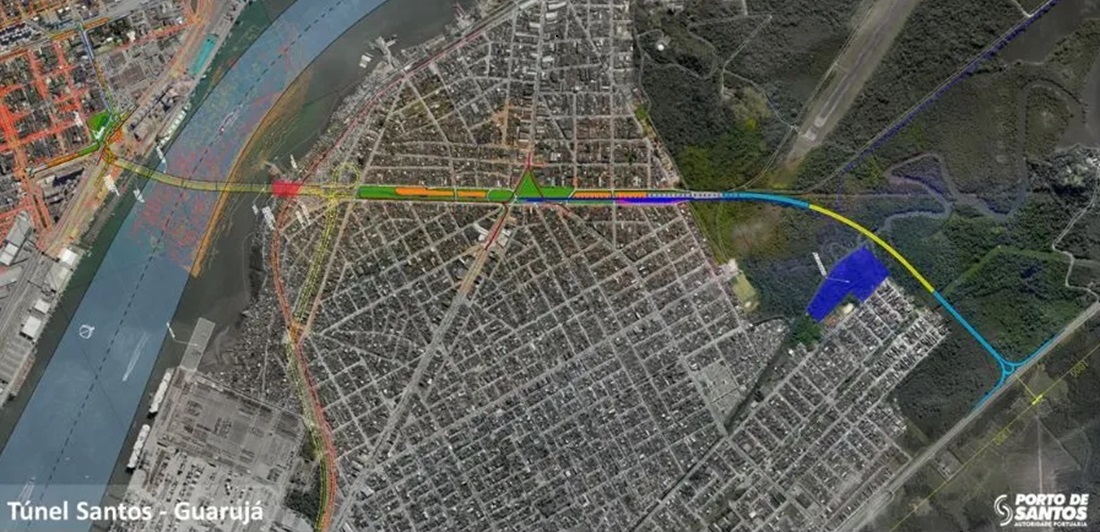
Santos-Guarujá Tunnel: hearings scheduled to discuss environmental impacts
Sep, 09, 2024 Posted by Gabriel MalheirosWeek 202436
São Paulo State Environmental Council (Consema) has scheduled two public hearings in October to discuss the Environmental Impact Study (EIA-Rima) on the underwater tunnel between Santos and Guarujá.
The first hearing will take place on October 9 at 5 p.m. at the Guarany Theater in Santos (Praça dos Andradas, 100, Centro). The second hearing will be held the following day, at the same time, at the Procópio Ferreira Theater in Guarujá (Avenida Dom Pedro I, 350, Jardim Tejereba).
Registration for participation will be done in person on the same days and locations as the hearings. The EIA-Rima can be accessed at the following link: https://cetesb.sp.gov.br/licenciamentoambiental/eia-rima/
Unlike previous hearings that focused on the project, the upcoming sessions will specifically address the environmental impacts of tunnel construction, including the displacement of residents.
Licensing Process
The state government submitted the EIA-Rima to the Environmental Agency of São Paulo (Cetesb) in early July for review. However, there is still no official stance on the document. If Cetesb certifies the project’s environmental feasibility, it will issue a preliminary license (LP).
On August 24, Cetesb closed the public comment period on this process. The public consultation period lasted 45 days. In a statement, Cetesb noted that public input and feedback from relevant authorities will be considered in the ongoing review, along with the input gathered during the upcoming public hearings.
“In general, the preliminary license certifies the environmental viability of the project and sets requirements that must be met by the developer to obtain an installation license (IL),” the agency explained.
Next Steps
To obtain an IL, the responsible company must submit, among other things, the project’s administrative plan and detailed measures for mitigating and controlling environmental impacts during construction.
Cetesb explained that detailed information regarding expropriation and resettlement, as well as the corresponding measures to be taken by the developer, must be presented in this phase.
Once all requirements are met, the IL is issued with conditions and guidelines for starting the construction work. After the construction, the developer must request an operating license (OL), allowing the project to begin operation if Cetesb verifies that all conditions from the previous phases have been met.
Project
The new project under review is based on the original proposal from the now-extinct state company Dersa. It includes the construction of a twin tunnel in the Macuco neighborhood of Santos, which will require the expropriation of 124 properties in the city.
The EIA-Rima was developed by the Economic Research Institute Foundation (Fipe), contracted by the State Government.
City-wide Concerns
When contacted, the Santos City Hall reiterated the points it raised during public hearings held from April 17 to 19, advocating for minimal or no property expropriations and opposing the movement of trucks and the construction of overpasses in urban areas.
The municipal administration also wants the winning company of the tender to “present and implement solutions to minimize the increased traffic flow toward the tunnel access area.” The project submitted was the result of an agreement between the municipality and the state government.
State Seeks Private Investment for Project Progress
According to the reference timeline established by the Ministry of Ports and Airports (MPor) and the State Government, the project’s legal review was completed on August 31. The next phase is securing private investments.
The Federal Court of Accounts (TCU) and the State Court of Accounts (TCE) are expected to complete their reviews by February 24, 2025. The final deadline for adapting to the recommendations is set for March 17, and the public tender is scheduled for publication in July 2025.
The Tunnel Project
Announced in February 2024, the tunnel is a joint initiative between the São Paulo state government and the federal government. It will be carried out through a public-private partnership (PPP) with investments nearing R$6 billion.
The project is part of the state’s Investment Partnership Program and the federal government’s Growth Acceleration Program, with a public investment of R$ 5.1 billion split equally between the São Paulo state government and the federal government, alongside private sector participation.
The tunnel between Santos and Guarujá will span 1.5 kilometers, with the underwater section measuring 870 meters and positioned 21 meters below sea level. It will connect Outeirinhos and Macuco in Santos to the Vicente de Carvalho District in Guarujá. The project includes a bike lane, a pedestrian walkway, and three lanes in each direction, with one adaptable for a Light Rail Vehicle (LRV).
The tunnel will benefit around 28,000 daily users of the ferry and raft systems, significantly reducing crossing time. Heavy vehicles heading to the port terminals must travel a 43-kilometer road route nowadays.
Public Hearings
The environmental licensing process follows the closing of the public hearing phase of the tunnel project’s implementation. Three public hearings were held on April 17, 18, and 19 at the Santos Commercial Association in Santos; the Procópio Ferreira Theater in Guarujá; and the Santos Port Authority (APS).
The public consultation was held between March 14 and May 3. According to the report, approximately 30% of the 94 contributions were addressed.
Source: A Tribuna
Click here to read the original text: https://www.atribuna.com.br/noticias/portomar/tunel-santos-guaruja-audiencias-s-o-marcadas-para-discuss-o-sobre-impactos-1.433034
-
Grains
Jul, 09, 2020
0
Brazilian cotton exports grow by over 50% in the first half of 2020
-
Ports and Terminals
Dec, 12, 2023
0
Private terminals hold 40% of container traffic in 1Q23
-
Ports and Terminals
Feb, 01, 2024
0
Port of Santos Welcomes Record-Breaking 366-Meter Vessel
-
Ports and Terminals
Nov, 23, 2020
0
CODESA launches public notice to lease two areas at Vitória port

